The Definitive Guide to Smoking Pork Shoulder: Achieve Fall-Apart Pulled Pork Perfection Every Time
Few culinary experiences rival the satisfaction of preparing a perfectly smoked pork shoulder, often referred to as pork butt. This beloved cut of meat, when treated with patience and the right techniques, transforms into succulent, fall-apart tender pulled pork that is not just a meal, but a true event. It’s one of the most rewarding barbecue dishes you can master, offering an incredible depth of flavor and a texture that simply melts in your mouth.
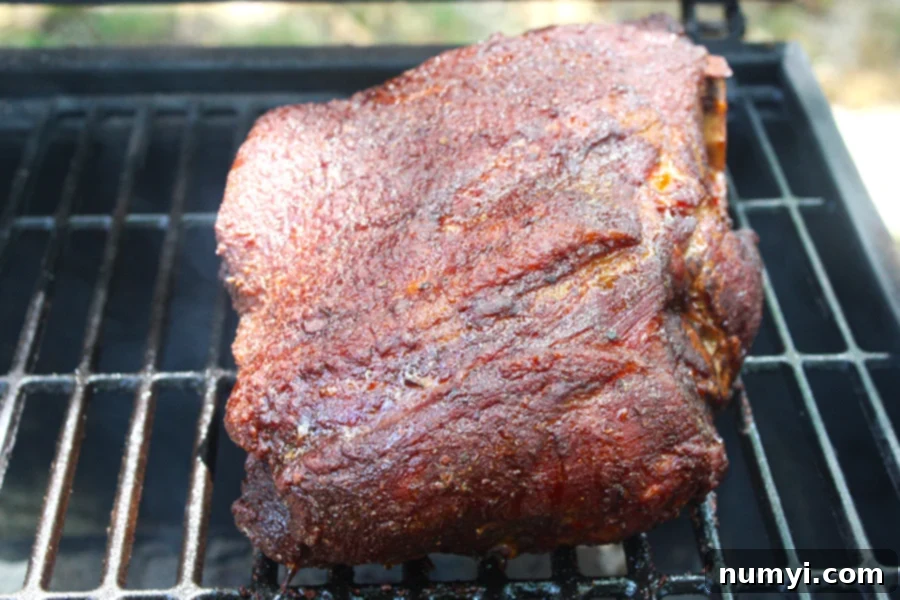
Why This Smoked Pork Butt Recipe Stands Out
Smoking pork butt is more than just cooking; it’s an art form that brings people together. Our method for smoked pork butt consistently delivers an exceptional result, making it a cornerstone of any backyard barbecue. The deep, rich smoke flavor combined with a meticulously crafted spice rub creates an irresistible crust, known as “bark,” that encases incredibly juicy, fall-apart tender pulled pork. The experience is truly unparalleled – every time we unveil a smoked pork butt from the smoker, it’s a moment of pure culinary delight, reminiscent of childhood excitement.
If you’re looking to host an unforgettable gathering or simply treat your family to some of the best barbecue they’ve ever tasted, this recipe is your secret weapon. The long, slow cooking process is the key to unlocking the most flavorful and tender meat imaginable. While it demands patience, the ultimate reward of a perfectly smoked pork shoulder is undeniably worth every minute of effort. Many friends and family members have declared this the best smoked pork shoulder they’ve ever had, and that praise alone makes the early morning start completely worthwhile.
When the smoker is fired up, it’s also a fantastic opportunity to prepare other barbecue favorites. We often accompany our pork butts with our highly popular smoked chicken wings and delectable smoked baby back ribs. If you’re a fan of ribs that literally fall off the bone, be sure to explore those recipes too.
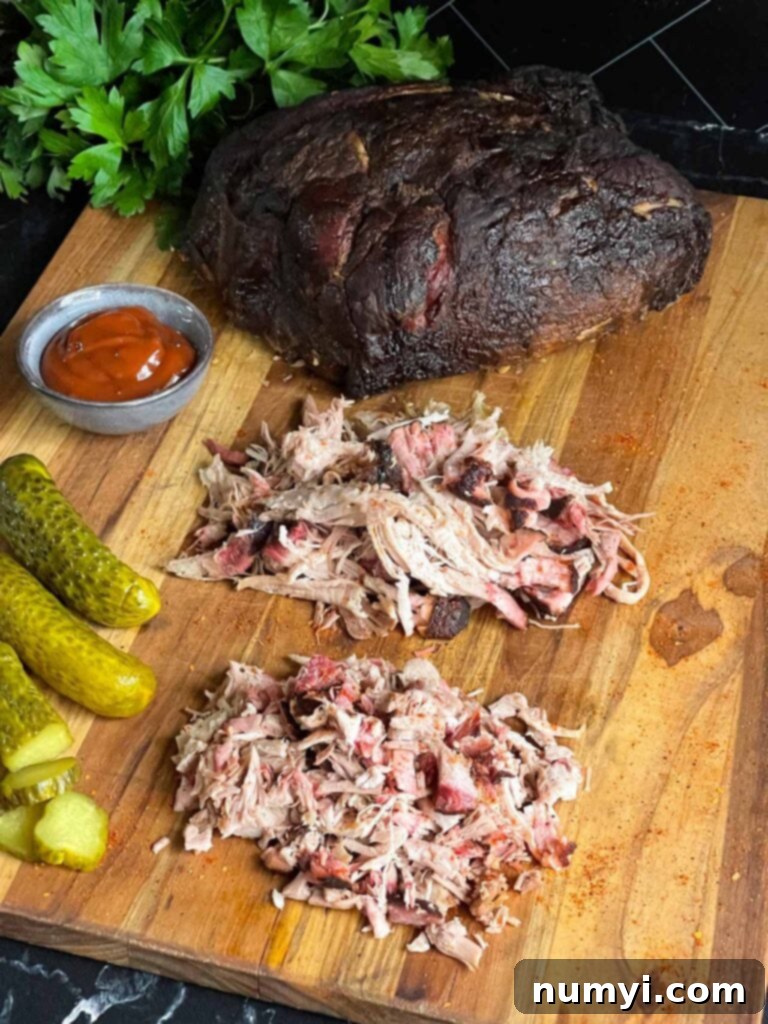
Unlocking Moisture and Flavor: The Magic of Pork Shoulder Brine!
While there’s no single “trick” to perfect smoked pork, there is a game-changing technique that elevates the final product: brining. If you’ve never tried it, prepare to be amazed. The primary goal during the extended smoking process is to keep the meat incredibly moist and tender. The most effective ways to achieve this are either injecting the pork butt with a flavorful liquid or, our preferred method, brining it.
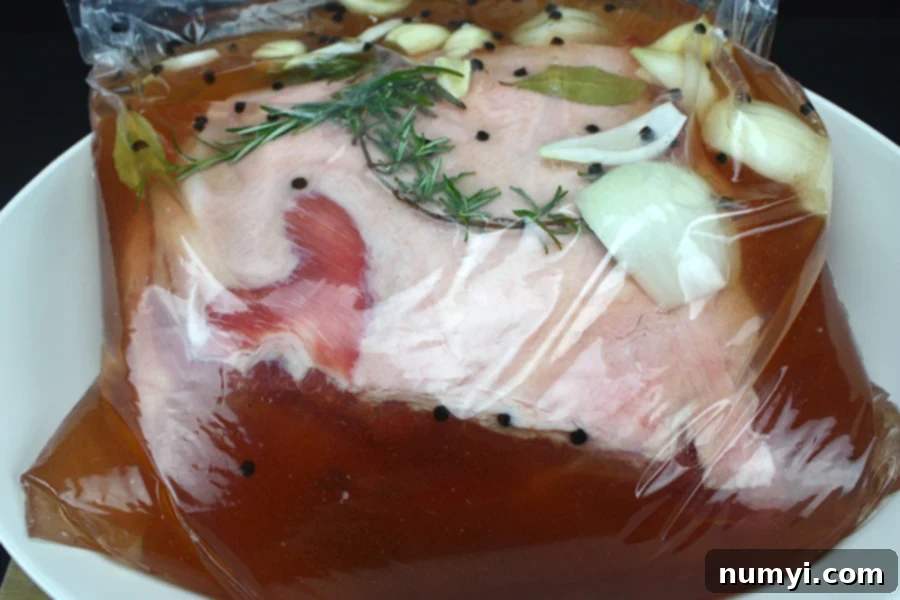
Brining involves submerging the pork shoulder in a saltwater solution, often enhanced with sugar and spices, for an extended period. This process works on two levels: first, it introduces moisture into the meat cells through osmosis, making the cooked pork significantly juicier. Second, it allows flavors from the brine to penetrate deep into the meat, enhancing its overall taste. We regularly brine our pork, and you can find a detailed explanation and our simple, effective pork shoulder brine recipe here.
In essence, brining ensures the meat remains exceptionally moist throughout the long cook, resulting in that coveted crisp bark on the outside and unbelievably tender meat that effortlessly pulls apart with your fingers on the inside. So, let’s get started on this incredible journey to smoked pork perfection!
Crafting the Perfect Rub: Essential Ingredients for Your Smoked Pork Butt
The dry rub is absolutely critical to developing that fantastic bark and infusing your pork butt with layers of flavor. While you can certainly use your favorite store-bought rub, we highly recommend trying our Memphis-style blend. It’s perfectly balanced for pork and versatile enough to use on other cuts like ribs.
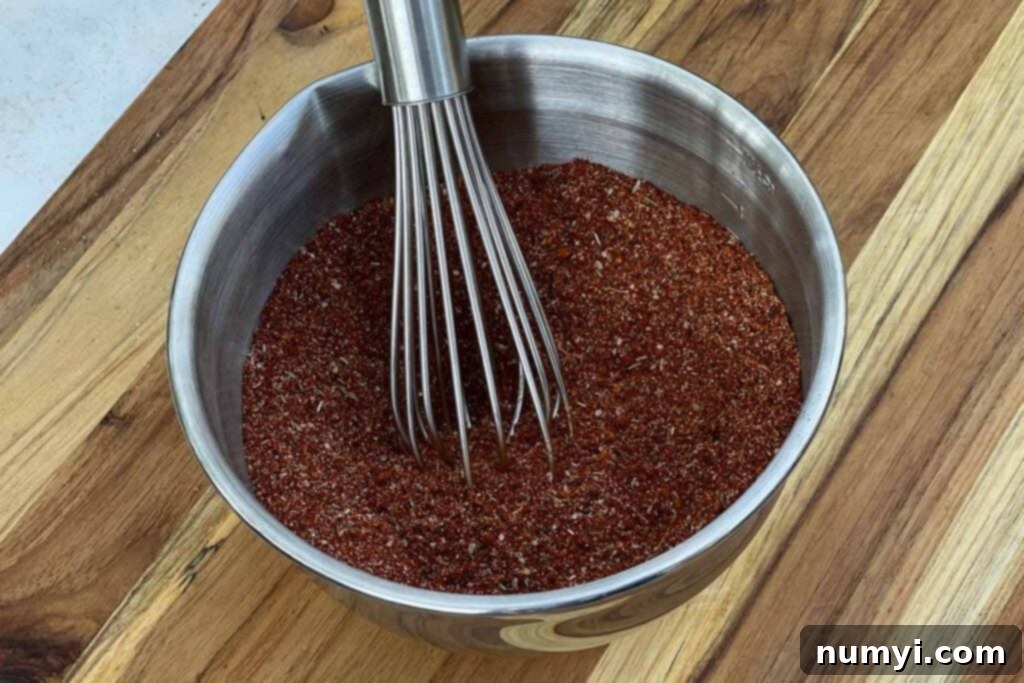
Our signature rub embodies the rich, complex flavors of authentic Memphis-style barbecue. Over the years, I’ve experimented with countless combinations, but I always return to this blend because it consistently hits all the right notes for a phenomenal pork rub. Here’s a breakdown of the key ingredients and what each contributes:
- Paprika – This forms the vibrant color and earthy foundation of our Memphis-style rub, providing a classic barbecue hue.
- Smoked paprika – Going beyond regular paprika, the smoked variety adds an extra layer of deep, smoky aroma and flavor directly to the rub, complementing the natural smoke from your cooker.
- Garlic powder – A versatile aromatic that adds a subtle, savory depth without overpowering the other spices.
- Chili powder – Another essential in any robust barbecue rub, chili powder contributes a mild heat and complex spice notes.
- Kosher salt – Absolutely indispensable for seasoning the meat, drawing out moisture, and enhancing all other flavors. It’s the primary flavor enhancer.
- Black pepper – Provides a sharp, pungent kick and adds a peppery bite that contrasts beautifully with the richness of pork.
- Onion powder – Similar to garlic powder, onion powder rounds out the savory profile, adding fullness and a slightly sweet, pungent note.
- Brown sugar – This is crucial for balancing the savory and spicy elements with a touch of sweetness. The molasses in brown sugar also aids in caramelization, contributing to that desirable bark.
- Dried oregano – Lends an herbaceous, slightly peppery, and aromatic quality that adds complexity to the overall flavor profile.
- Cumin – Known for its warm, earthy, and slightly smoky notes, cumin further deepens the barbecue flavor.
- Dry mustard – Adds a subtle tang and a gentle heat, cutting through the richness of the pork and providing a zesty undertone.
- Cayenne powder – This ingredient allows you to customize the heat level. Add more for a spicier rub, or less for a milder flavor, depending on your preference.
To prepare the rub, simply combine all the ingredients in a small bowl and mix thoroughly until well blended. I prefer brown sugar for its molasses content, which I believe adds a richer flavor and helps form a better bark. However, if you prefer, you can substitute it with white sugar.
The Ultimate Method: How To Smoke a Pork Shoulder (Pork Butt)
Let’s outline the precise steps to achieve that perfect pulled pork, ready to be devoured by Saturday afternoon. This detailed timeline ensures maximum flavor and tenderness:
Thursday Evening: Brining Begins
To kick things off, around Thursday night, I’ll place my pork shoulder (also known as pork butt or Boston Butt) into the prepared brine. These cuts are readily available at most grocery stores; I often buy a couple at a time to ensure I always have some on hand.
Pro Tip
Before brining, take a moment to inspect the fat cap on your pork shoulder. If there’s an excessive amount of thick fat, it’s wise to trim some of it off. While a certain amount of fat is essential for moisture and flavor, an overly thick layer can prevent the smoke and rub from properly penetrating the meat, resulting in less flavorful bark.
Friday: Rub Application and Overnight Rest
After 18-24 hours in the brine, pull the pork shoulder out and let it rest on a wire rack over a baking sheet for a couple of hours. This allows excess brine to drain and the surface to dry slightly, which is crucial for rub adhesion and bark formation.
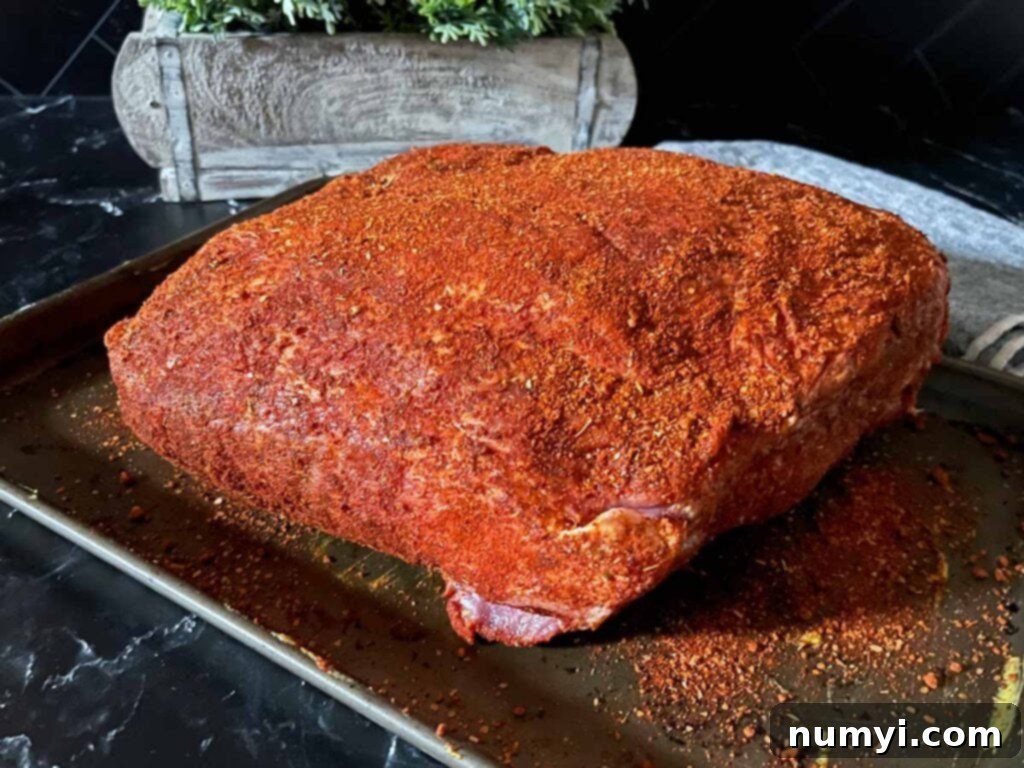
Once the meat has drained and is relatively dry, it’s time for the rub. Apply a generous, even layer of yellow mustard all over the entire surface of the pork butt. The mustard acts as an excellent binder, helping the dry rub adhere effectively. Don’t worry; the mustard flavor won’t be noticeable in the final product. Immediately after applying the mustard, liberally coat all sides with your Memphis-style dry rub, patting it gently to ensure it sticks. Once fully coated, wrap the pork butt tightly and refrigerate it overnight. This allows the rub to work its magic, drawing out moisture and creating a sticky surface perfect for bark development. Some barbecue enthusiasts also like to spritz their meat with apple juice or apple cider vinegar during the cook, but I find that with proper brining and the mustard binder, it’s not strictly necessary.
Don’t Sweat The Recipe is supported by its readers. We may earn a commission if you purchase through a link on our site. Learn more.
Selecting Your Smoking Wood
The type of wood you choose dramatically impacts the final flavor profile of your smoked pork butt. After extensive experimentation, I’ve found that using unsoaked wood chips or chunks yields superior results. The goal is to generate clean smoke as quickly as possible, rather than waiting for water to evaporate from soaked chips. Therefore, do not soak your wood chips or chunks.
For offset smokers, you’ll typically need to add new wood chunks approximately every 45 minutes to an hour. Keep a close eye on your smoke output; when it thins or disappears, it’s time to add a couple more hickory chunks. Pellet smokers and gravity-fed smokers usually manage smoke production automatically, making them a bit more hands-off.
In my experience, hickory or pecan wood are the best choices for smoking pork shoulder. I personally prefer an assertive smoke flavor for my pulled pork, and hickory delivers that perfectly without being overwhelming like mesquite can sometimes be. Some prefer fruit woods, such as apple wood or cherry wood, which impart a sweeter, milder smoke that pairs beautifully with pork. Ultimately, the best wood is the one you enjoy most.
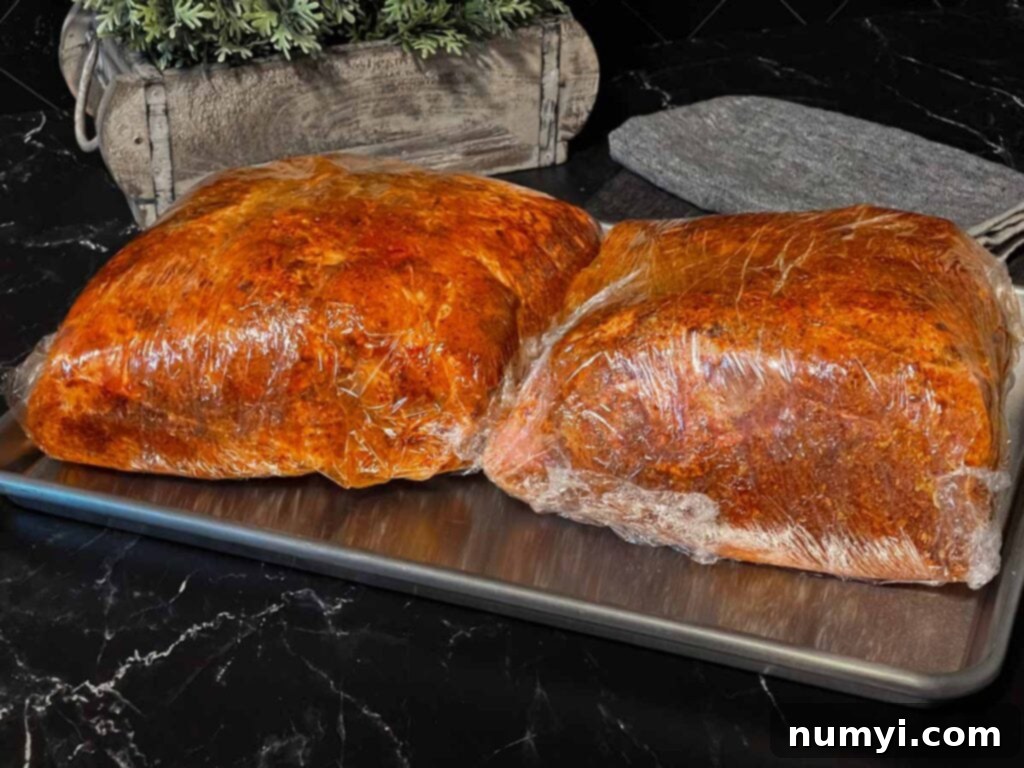
Saturday Morning: The Smoking Begins
An average 8-pound pork shoulder will require approximately 12 hours of smoke time. To have dinner ready by 4 PM, I’m typically up by 3:30 AM to start my charcoal and get the smoker preheating. My target temperature for the smoker or grill is between 225-250°F before the meat goes on. For an offset smoker, it usually takes me about this long to get the temperature stabilized and consistent.
If you’re using a dedicated smoker, this preheating process might be quicker. Those with a Weber-style grill can also smoke a pork butt by setting up an indirect heat zone. Place the meat on one side of the grill, away from the direct heat source, and use wood chunks for smoke.
Just before placing the pork butt on the smoker, you might want to add a final, light dusting of rub to ensure maximum flavor and bark development.
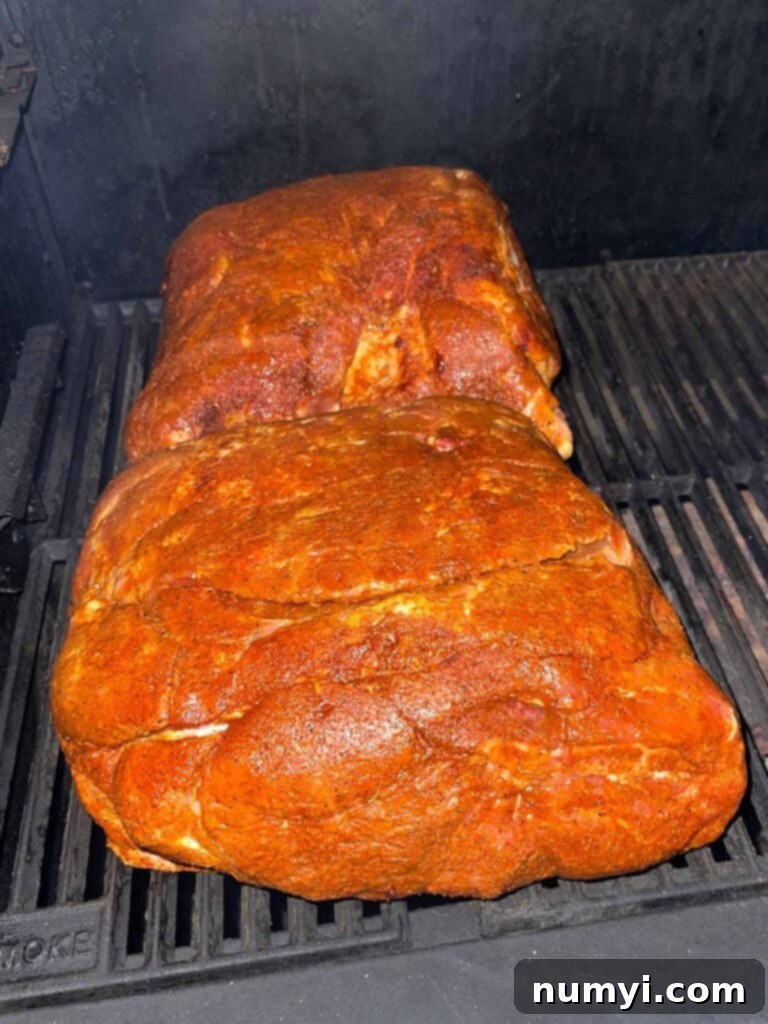
Place the pork butt on the grill grate with the fat side facing up. This is often a point of debate among pitmasters. Some argue that the fat cap facing up will slowly baste the pork butt as it renders during smoking, adding moisture and flavor. Others contend that placing the fat side down provides a protective barrier for the meat, preventing it from drying out. I’ve experimented with both orientations and have consistently achieved excellent results, so ultimately, it comes down to personal preference.

Allow the meat to smoke for the first 6 hours unwrapped. During this critical initial phase, constantly monitor your smoker’s temperature. It’s crucial to maintain a consistent range of 225-250°F. You may need to add more wood or adjust your vents to keep the fire stable and the smoke flowing. If you chose not to brine your pork butt, consider spritzing it every hour or so with a 50/50 mix of apple cider vinegar and water to help keep it moist and promote a good bark.
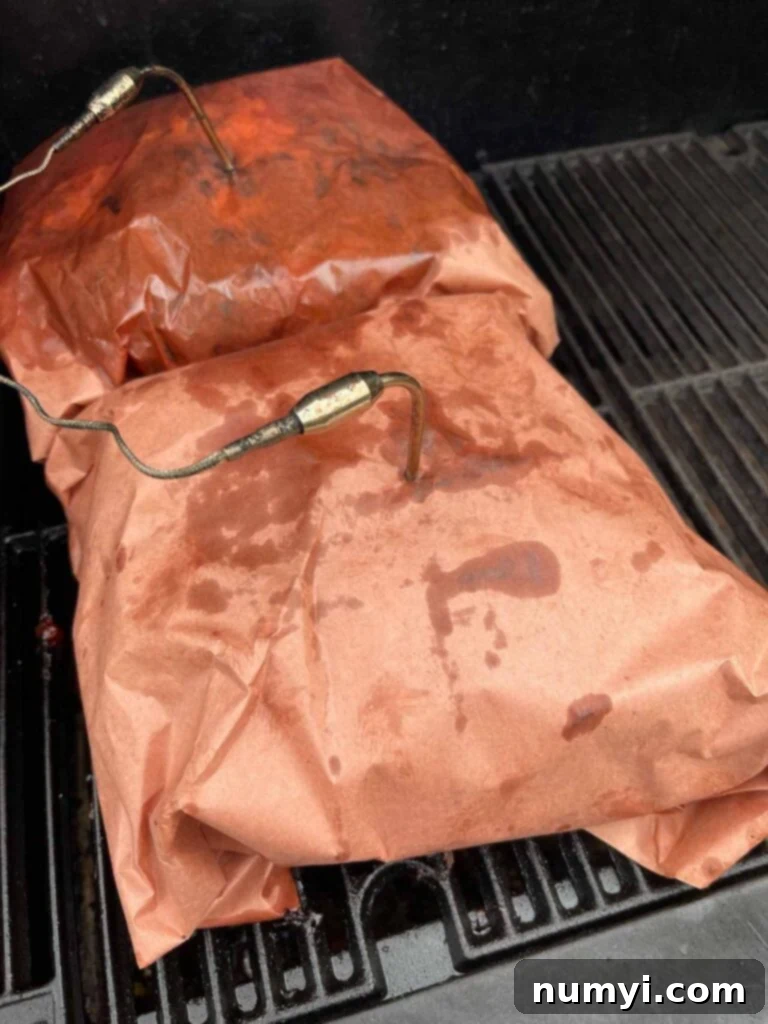
The Wrapping Stage: Combating “The Stall”
After approximately 6 hours of smoking, pull the pork butt off the smoker. At this point, it’s time to wrap it securely in butcher paper. While some prefer aluminum foil, butcher paper is superior because it allows some moisture and smoke to escape, preventing the meat from stewing in its own juices and preserving that desirable bark. This wrapping technique is often called the “Texas Crutch” and serves several important purposes, primarily helping the meat power through “the stall” (more on that in the Pro Tips section) and accelerating the cooking process while still allowing good smoke penetration in the early stages.
Return the wrapped pork butt to the smoker, maintaining the 225-250°F temperature. Continue cooking until the internal temperature reaches the desired range. I typically start checking the internal temperature around the 11-hour mark. The ideal internal temperature for fork-tender pulled pork is between 192-195°F. At 11 hours, I’m usually right around 190°F, indicating it’s almost ready.
Important Note
When the internal temperature of the pork butt reaches approximately 180°F, a crucial transformation begins: the connective tissues and collagen within the meat start to break down. This is the scientific reason behind the meat becoming incredibly tender and juicy. While 180°F marks the start, allowing it to reach 192-195°F ensures that all those tough fibers have rendered, giving you the melt-in-your-mouth texture you crave.
Resting and Shredding: The Final Steps to Perfection
Once your pork butt reaches the target internal temperature and probes tender (meaning an instant-read thermometer slides in with very little resistance), it’s time to pull it off the smoker. However, the cooking process isn’t quite finished – an essential resting period follows. You’ll be tempted to tear into it immediately, but resist! The meat is extremely hot, and more importantly, it needs time to rest.
Allow the pork butt to rest for at least an hour, though we often let ours rest for 90 minutes to two hours. This resting period is crucial for the juices within the meat to redistribute evenly. If you cut or shred it too soon, those precious juices will simply run out, leaving you with drier, less flavorful meat. While it rests, you might also need to guard your masterpiece from enthusiastic family members – especially those who, like my wife, have a knack for “sampling” the delicious smoked ends like a cobra striking its prey!
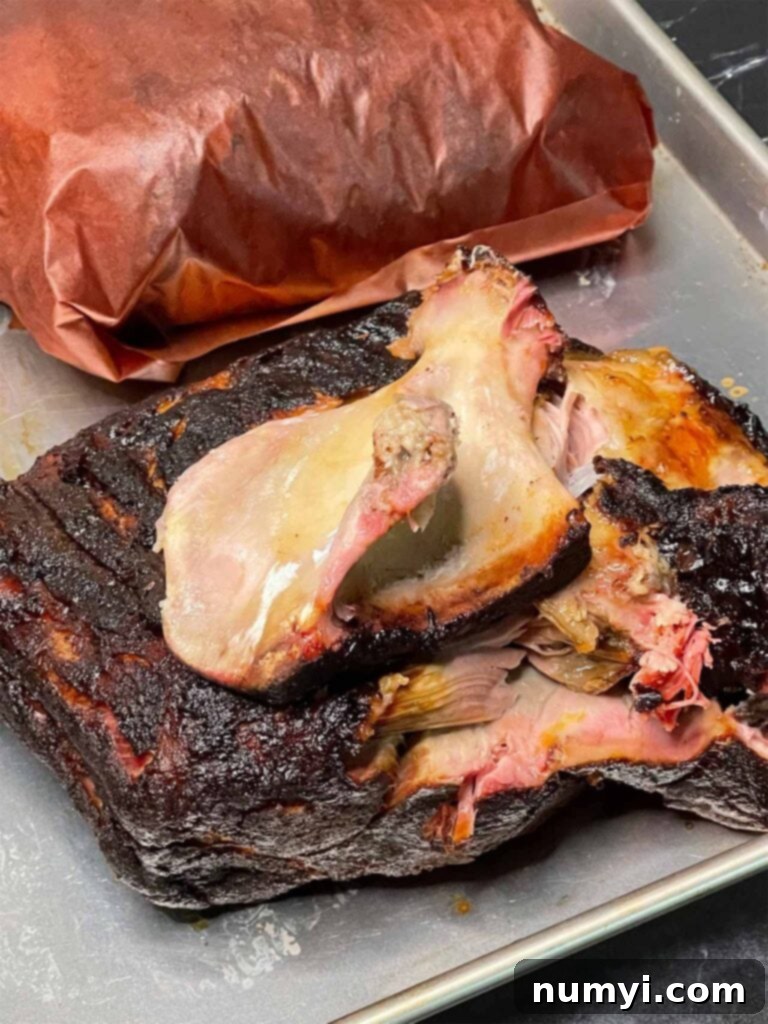
After the resting period, carefully transfer the pork butt to a large rectangular pan or a cutting board with a juice groove, as delicious juices will inevitably run out. Now for the most satisfying part: grab hold of that shoulder bone. If cooked to perfection, it should slide out cleanly with minimal effort. While still warm, use a pair of meat claws or sturdy forks to begin shredding the pork. Once it cools down a bit, your fingers work just as effectively for pulling apart the tender strands.
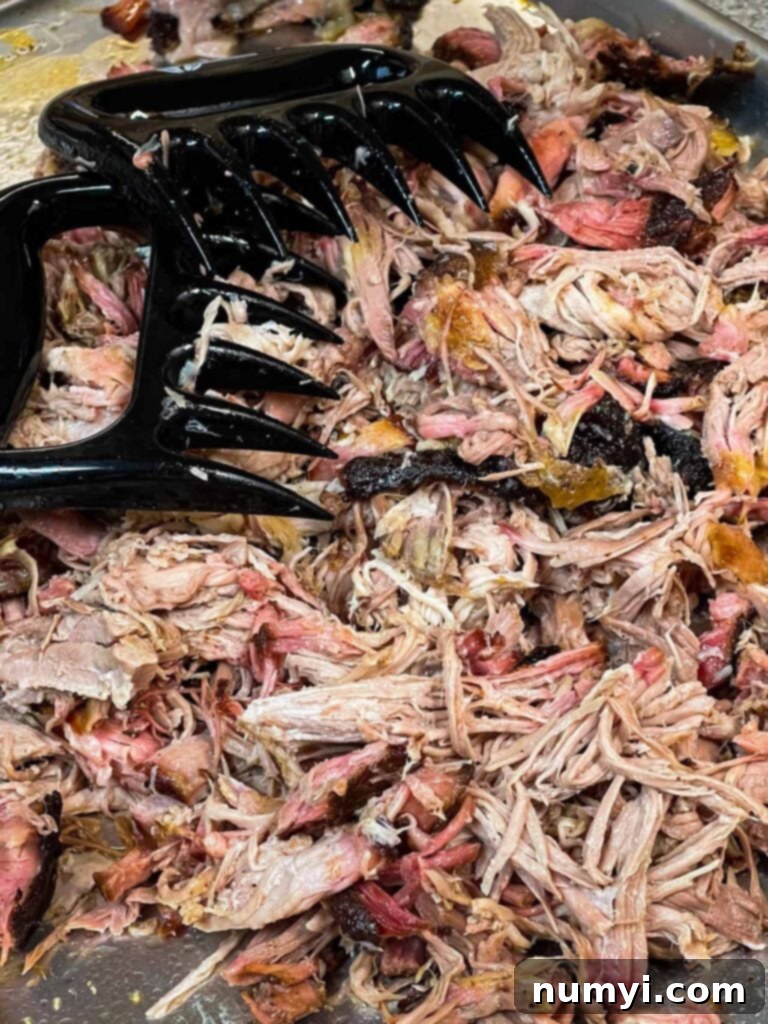
Behold! Smoked pulled pork HEAVEN awaits! You’ll be rewarded with incredibly juicy meat, a beautiful smoke ring indicative of a slow cook, and that irresistible, flavorful bark that crumbles with every bite.
Now, the only challenge left is deciding how to enjoy this culinary masterpiece.
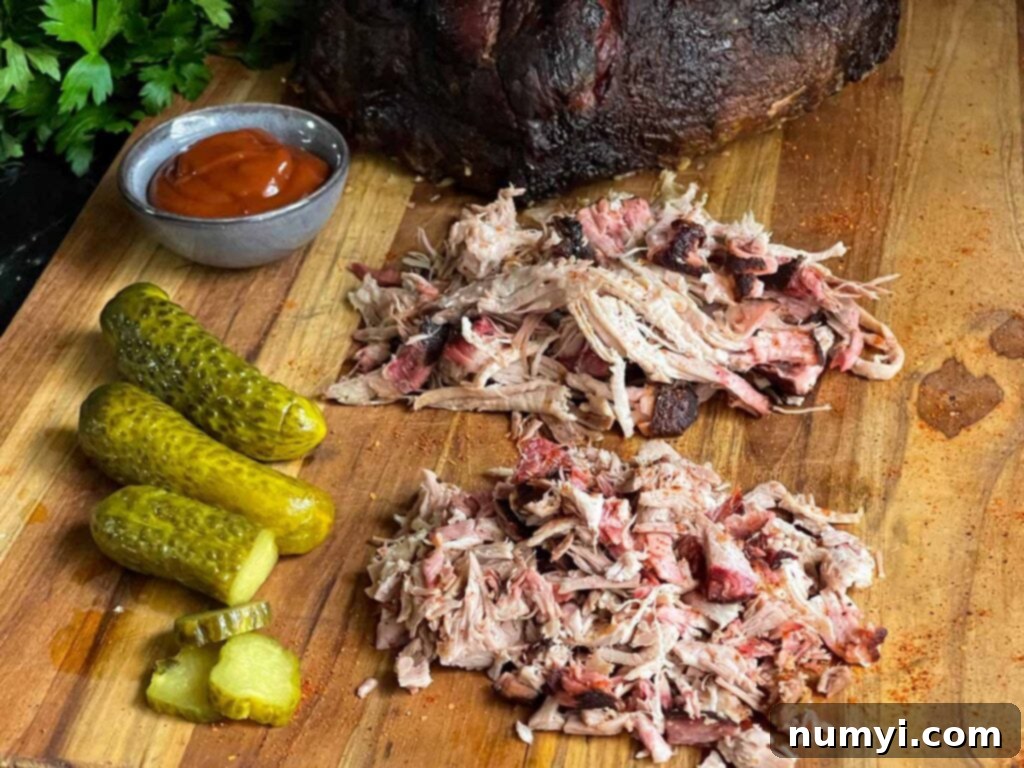
I’m a big fan of classic pulled pork sandwiches, loaded with some tangy pickles and a side of chow-chow. A few quick passes with a cleaver transform a portion into perfectly chopped pork for those who prefer it. My wife, on the other hand, enjoys adding a touch of her favorite BBQ sauce and eating it straight, without a bun. Feel free to pair it with any BBQ sauce you love; it’s truly delicious every which way!
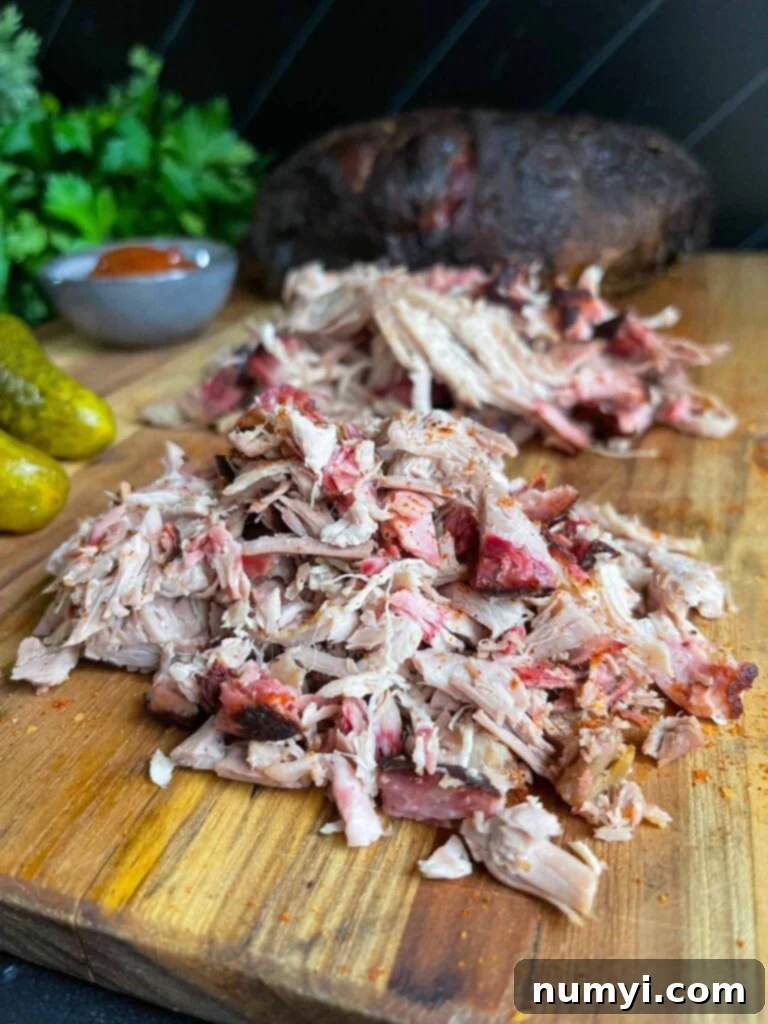
Wondering what to serve alongside your new favorite pulled pork recipe? You can never go wrong with a fresh herb potato salad, a creamy coleslaw, or some banging barbecue baked beans. These classic sides perfectly complement the rich flavors of the pork.
Enjoy the fruits of your labor, and happy BBQing!
Expert Tips for Smoking Pork Shoulder
Having smoked countless pork butts over the years, I’ve gathered a wealth of knowledge. Here are some invaluable tips that will help you achieve consistent, mouthwatering results every time.
Prioritize Temperature Over Time
A common guideline suggests that smoking a pork butt at 225-250°F takes approximately 90 minutes per pound. While this is a useful rough estimate, it’s crucial to understand that numerous factors – the specific cut of meat, ambient temperature, humidity, and even how often you open your smoker – can throw this off. Therefore, **always smoke to internal temperature, not solely by time.**
- At 165°F, the pork is safely cooked, but the connective tissues haven’t broken down sufficiently for it to be truly tender or “pullable.”
- Around 180°F, the magic begins. This is when the tough collagen and connective tissues start to render and break down into gelatin, initiating the tenderization process.
- By 190°F, the pork butt will be quite tender. However, for that ultimate, melt-in-your-mouth, fork-tender texture, I highly recommend letting it cook further.
- The sweet spot for ideal tenderness is usually between 195-200°F. When I smoke a pork butt, I consistently aim to pull it off at 195°F. At this temperature, the meat is consistently fork-tender without becoming mushy or overly soft. If you desire pulled pork that truly melts in your mouth, this is the temperature range you should target.
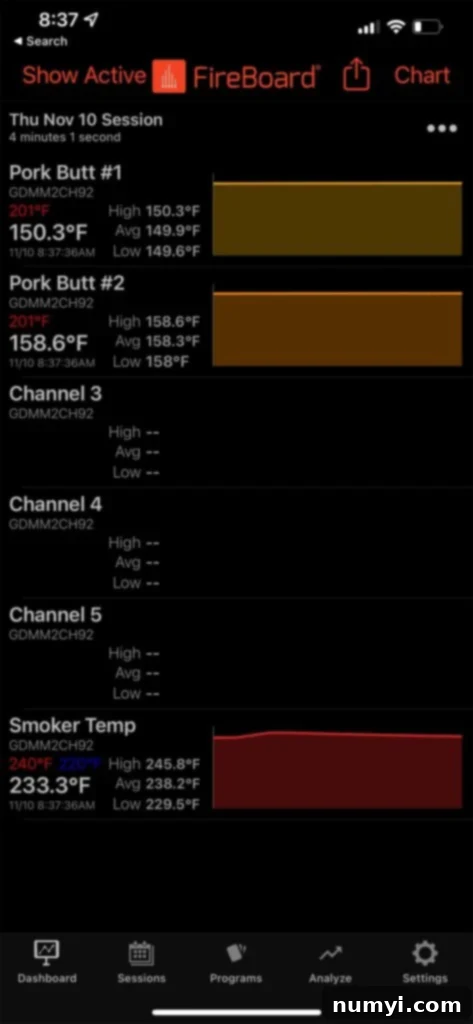
To accurately monitor your meat’s internal temperature, investing in a reliable thermometer is essential. I typically use a Fireboard for continuous temperature tracking throughout the cook. Additionally, an instant-read thermometer is indispensable for quick spot checks and, more importantly, for assessing “probe tenderness.” When the probe slides into the meat with minimal resistance, feeling like it’s entering soft butter, that’s the perfect indication that your pork butt is ready.
So, always remember: it’s all about the internal temperature of the pork butt, not just the clock on the smoker.
The Impact of Wood Selection
While I generally advise using the wood you prefer, I must admit my bias when it comes to smoking pork. Here in the South, we are renowned for our smoked pork, and a key to that tradition is the use of hickory wood. When I smoke pork butt, hickory is my go-to choice every single time. It provides an aggressive, robust smoke flavor that perfectly complements the richness of pork, yet it’s not as overwhelmingly strong as mesquite.
I wholeheartedly recommend hickory for smoked pork butts because I want that profound smoky goodness to shine through in every bite of pulled pork, making that delicious bark sing with flavor. I’ve also had fantastic results using a blend of hickory and oak, which offers a slightly different but equally satisfying smoke profile. Pecan is my second favorite, providing a milder, nutty smoke that still pairs wonderfully with pork.
For those looking to add a delightful fruitiness that harmonizes exceptionally well with pork, apple wood is an amazing option, imparting a sweet, subtle smoke. While I understand that regional preferences vary, if you’re aiming for authentic, deep South-style pulled pork, give hickory a try – you won’t be disappointed.
Understanding ‘The Stall’
“The stall” is a common phenomenon encountered when smoking large cuts of meat, such as pork shoulder, at low and slow temperatures for extended periods. It typically occurs when the meat’s internal temperature reaches between 150-170°F. During this phase, you might notice that the meat’s temperature stops rising, or even slightly drops, for several hours. This can be quite disconcerting for new pitmasters, but rest assured, it is a normal part of the process and no cause for alarm.
What’s happening during the stall is evaporative cooling. As the meat cooks, moisture from its surface evaporates, and this evaporation cools the meat, much like how sweat cools our bodies on a hot day. This cooling effect temporarily counteracts the heat from the smoker, causing the temperature plateau. The duration of the stall can vary significantly based on factors like the size of the pork butt, the fat content, and even the relative humidity in your environment.
To power through the stall and accelerate the cook, many pitmasters employ a technique known as the “Texas Crutch,” which involves wrapping the pork in either aluminum foil or butcher paper. As outlined in our recipe, we recommend wrapping the pork butt around the 6-hour mark, which conveniently aligns with when the stall typically begins, helping to either significantly reduce its duration or eliminate it entirely.
To Wrap or Not To Wrap?
Wrapping the pork butt, as described in this recipe, serves a dual purpose, making it a highly effective technique for consistent results. Firstly, while you want good smoke penetration, you don’t necessarily want 12 hours of uninterrupted heavy smoke, as this can make the meat taste bitter or “over-smoked.” Wrapping the pork after 6 hours prevents further smoke from penetrating the meat, allowing the initial smoke flavor to mellow and integrate beautifully. If you desire more intense smoke flavor, you can delay wrapping; for a lighter smoke profile, wrap it sooner. Our recommended 6-hour mark strikes the perfect balance.

Secondly, wrapping directly addresses “the stall” by creating a micro-environment around the meat. The paper or foil traps moisture, preventing evaporative cooling and allowing the internal temperature to rise more quickly. While barbecue purists sometimes argue that wrapping can compromise the bark, my experience with butcher paper shows that this is largely unfounded. Butcher paper is breathable enough to maintain a good bark, unlike aluminum foil, which can indeed steam the meat and soften the bark. If you absolutely prefer not to wrap and encounter the stall, a simple solution is to increase your smoker’s temperature by about 10-15°F until the meat powers through the plateau, then return it to your target temperature.
Smoking a Pork Butt Ahead of Time
While smoking a pork butt is a time-intensive process, it doesn’t mean you have to be up at midnight to have it ready for a midday party. This recipe allows for convenient preparation ahead of time, ensuring you can enjoy your gathering without stress.
Simply smoke the pork butt following the instructions a day before your event. Once it’s cooked and rested, shred the pork, making sure to retain all the flavorful juices. Transfer the shredded pork and its juices into disposable aluminum foil pans. Seal the pans tightly with foil and refrigerate them overnight.
On the day of your event, reheat the pulled pork in an oven, on the grill, or back in your smoker at a low temperature of 225°F until it is thoroughly heated through, which typically takes about 30-40 minutes. The retained juices will keep the pork moist and delicious, making it taste freshly smoked. Serve and enjoy!
Delicious Variations to Customize Your Pulled Pork
One of the beauties of smoked pork shoulder is its versatility. Once you’ve mastered the basic technique, you can easily experiment with different flavors to suit your palate. Here are some variations to consider:
- Binders – Our recipe uses classic yellow mustard as a binder to help the rub adhere. It’s a fantastic choice as its tanginess subtly enhances the bark and the flavor disappears during the long cook. Olive oil is another solid, neutral option that works just as well. Honestly, even without any binder, the rub will still adhere, especially if the meat is allowed to rest and dry slightly. If you opt out of using mustard or another binder, I highly recommend frequent spritzing (every 30-60 minutes) with a 50/50 mix of water and apple cider vinegar to maintain moisture and promote bark.
- Rubs – The world of barbecue rubs is vast and exciting! While I’m a staunch advocate for our homemade Memphis-style rub, don’t hesitate to explore. I’ve also enjoyed using commercial rubs like Bad Byron’s Butt Rub, which is a fantastic, savory blend. Meat Church offers a range of highly popular and excellent rubs, often found at outdoor sports retailers like Academy Sports. Experimenting with different flavor profiles, from sweet and spicy to savory and herbaceous, can completely transform your pulled pork.
- Wood – As mentioned, wood choice significantly alters the smoke flavor. While hickory remains my top choice for its robust character, don’t be afraid to mix it up occasionally. Apple wood, with its sweet and mild smoke, pairs exceptionally well with pork and adds a lovely fruity note. Cherry wood also offers a similar sweet, subtle smoke with a beautiful reddish tint to the bark. Even a mix of different woods, like hickory and pecan, can create a complex and inviting flavor profile. Smoke with what you like best!
- BBQ Sauces – The array of barbecue sauces available is truly astounding, and there’s no wrong choice here – it all depends on your preference! If you’re a fan of a sweet-and-spicy combination, look for sauces with a good balance of sugar and chili. For those who love a tangy kick, explore mustard-based sauces, often found in North Carolina barbecue traditions. We’re particularly proud of our homemade Bourbon Chipotle Barbecue Sauce.
- Keto-Friendly Option – If you’re following a ketogenic diet, smoked pork shoulder is an ideal dish! To keep it keto-friendly, simply ensure your rub contains no added sugars. Bad Byron’s Butt Rub, for example, is widely available and a fantastic choice as it’s typically sugar-free and packed with a great blend of spices that complement pork perfectly. Enjoy this delicious, low-carb meal without compromise!
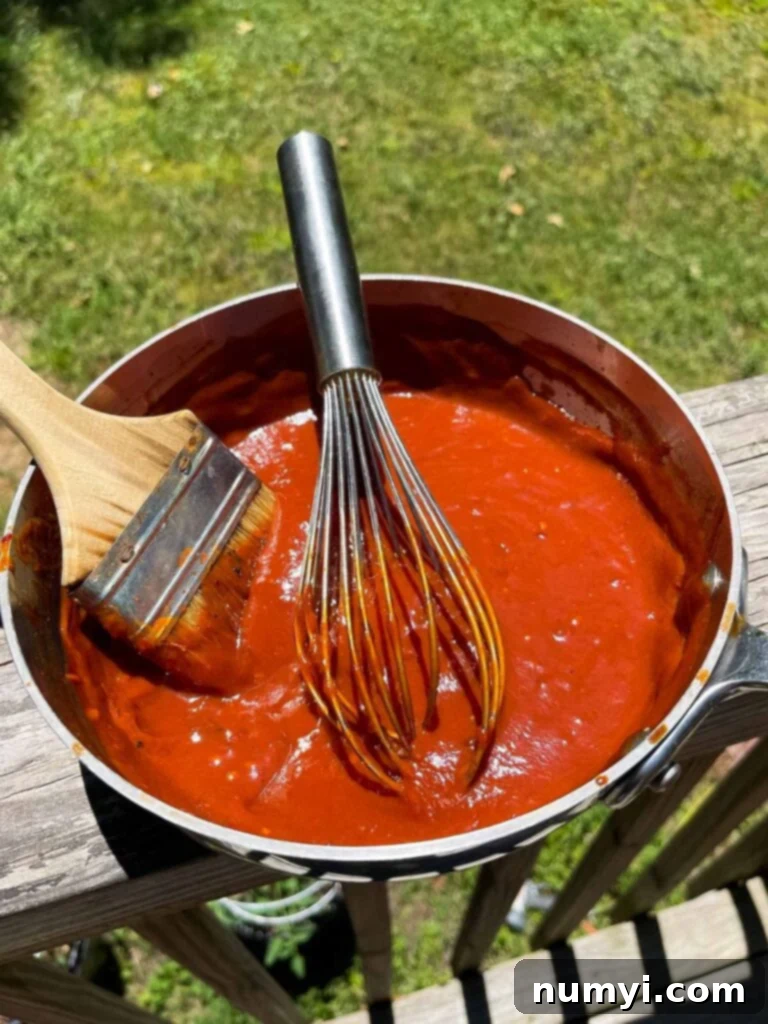
This sauce is ketchup-based, offering excellent sweet notes balanced by the smoky heat of chipotles. The bourbon adds a wonderful depth and complexity, making it an absolute pantry staple in our home. Plus, making it yourself means it’s fresher and often more flavorful than anything you’ll find in a store!
Frequently Asked Questions About Smoking Pork Shoulder
A standard 8 lb pork shoulder typically requires approximately 12 hours to smoke when maintained at a consistent temperature range of 225-250 degrees Fahrenheit. However, remember to always smoke to temperature, not strictly by time, as various factors can influence the total cooking duration.
The minimum resting time for a smoked pork shoulder is one hour. For optimal results, we highly recommend allowing it to rest for 90 minutes to 2 hours. This crucial resting period allows the muscle fibers to relax and reabsorb the internal juices, resulting in a significantly more tender and moist pulled pork.
For the absolute best results and melt-in-your-mouth tenderness, we aim for an internal temperature of 195 degrees Fahrenheit. The pork butt will technically be safe to eat at 165 degrees Fahrenheit, but it will not be tender enough to be easily pulled. At 180 degrees Fahrenheit, the connective tissues begin to break down, and it starts to become pull-apart tender. We recommend at least 190 degrees Fahrenheit for good tenderness, but 195-200 degrees Fahrenheit ensures exceptional, fork-tender pulled pork.
Discover More Amazing Barbecue Recipes
Fall-Apart Smoked Chuck Roast Recipe
Pork Butt Burnt Ends Recipe
Double Bone-In Smoked Pork Chops
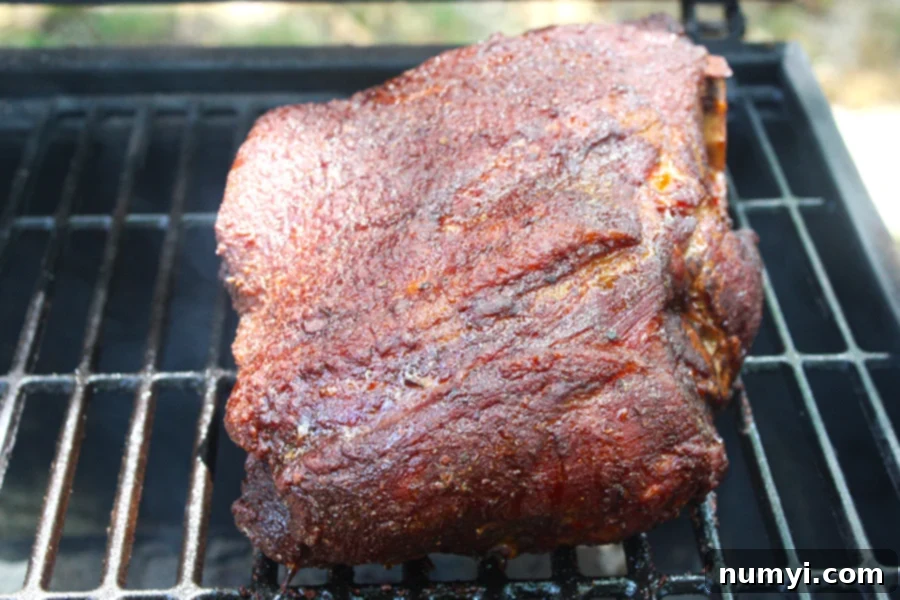
Smoked Pork Shoulder (Pork Butt) Recipe
Print
Pin
Rate
Ingredients
- 8 Lb Pork Shoulder (Butt)
Memphis Dry Rub (makes .5 cup):
- 1/2 cup Paprika
- 1/4 cup Chili powder
- 3 tbsp Kosher salt
- 3 tbsp Black pepper
- 3 tbsp Brown sugar
- 2 tbsp Smoked paprika
- 2 tbsp Garlic powder
- 2 tbsp Onion powder
- 1 tbsp Dried oregano
- 1 tbsp Cumin
- 2 tsp dry mustard
- 1 tsp cayenne pepper
Instructions
-
Begin by brining the pork shoulder for 18-24 hours. You can find our recommended pork shoulder brine recipe here.
-
After brining, remove the pork from the brine and allow it to rest on a wire rack for approximately 1-2 hours to drain excess moisture.
-
Apply a liberal and even amount of yellow mustard to the entire surface of the meat. This acts as a binder for the rub.
-
Generously apply your Memphis-style dry rub on all sides of the pork, rubbing or patting it firmly into the meat to ensure good adhesion.
-
Wrap the seasoned pork butt tightly and refrigerate it overnight, allowing the rub to further penetrate and develop flavor.
-
Preheat your smoker or grill to a consistent temperature of 225-250 degrees Fahrenheit. Place the pork butt on the grates, fat side up, and smoke for 6 hours.
-
After 6 hours, remove the pork butt from the grill and wrap it securely in butcher paper. If using tin foil, do not completely seal it to allow some moisture to escape, preserving the bark.
-
Return the wrapped pork to the smoker and continue cooking at 225-250 degrees Fahrenheit for approximately another 6 hours, or until desired internal temperature is reached.
-
Using a reliable meat thermometer, remove the cooked pork butt from the smoker when its internal temperature reaches 195-200 degrees Fahrenheit and probes tender. Allow it to rest for at least 1 hour (preferably 90 minutes to 2 hours) before shredding.
Notes
Our Memphis Dry Rub recipe yields enough rub to season approximately 4 standard-sized pork butts.
Always remember to smoke to the desired internal temperature, not just by time. The size of the pork butt, ambient weather conditions, and humidity levels can all significantly affect the total cooking time. Use a reliable thermometer to guide your cook.
